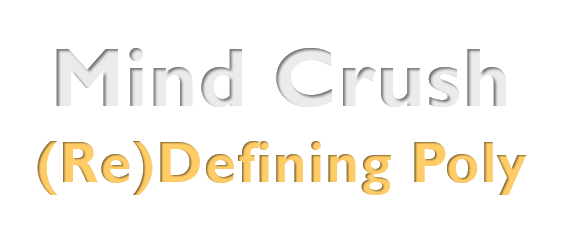I’ve resisted coming up with a specific vision or definition for what kind of polyamory I wanted to practice. To me, this was too similar to constructing the house of cards that I tried and failed to live up to before reinventing my life four years ago. This house of cards was an ideal that I couldn’t live up to. And, importantly, it was in fact never well suited for me to begin with. It was destined to cause me great misery. It did just that.
In choosing a polyamorous approach to relationships, I recognized there were important preferences that I needed to understand and make clear to potential partners. It is kind of definition. Or, perhaps more accurately, those preferences describe the ingredients that I use to define and redefine poly for myself. The first preference to note is that I’m an emotional dater. I don’t seem to have the capacity to have sex without forming attachment. I don’t do casual. I prefer emotional intensity which is reflected and reinforced in the bedroom. So, I have a bias for deeper, longer term relationships.
Because of my emphasis on the emotional side of relationships, I also have a large openness to romantic, non-sexual poly relationships. I had a wonderful romantic non-sexual relationship with an old friend, university classmate, and spiritual guide for many years. When that relationship suddenly ended as her husband came to resent our emotional closeness, I mourned that loss as deeply as any traditional romantic relationship I’ve ever had. I find these connections deeply fulfilling. Indeed, it was the way I unknowingly “practiced” polyamory for nearly all of my active dating life. I’ve nearly always had a very close, flirty, loving woman friend with whom I spent much time with when I wasn’t with my girlfriend. These women were usually potential lovers that I met at the “wrong time.” But, a few of them were also former lovers with whom the connection survived the end of the committed, sexual relationship.
I have a desire to let each relationship seek its own level. What I mean is that it does not make sense to me to establish an arbitrary boundary or limit on what any given relationship can become. We know entirely too little and life and love are too dynamic for those restrictions to consistently make sense over the course of many years. The practical implication of this bias towards fluidity in relationships is that I’m reluctant to define my relationships in a hierarchical fashion. The hierarchy that says you are primary and this other woman is secondary forecloses on the relationship dynamic before it even has a chance. I suppose that’s a feature, not a bug, of hierarchical relationships. It is just not a feature that I appreciate. I am comfortable, however, with the use of “primary” or “central” as a description of what currently is. But, much less comfortable with using those terms of art in a prescriptive manner, intended to confine current and future relationships into a specific, unchanging mold. I hope that it is also clear that my rejection of this prescription does not mean that I don’t seek and desire deeply committed, long-term relationships. I do.
The bias toward fluidity is perhaps related to my resisting the impulse to rigidly define a vision of polyamory for myself. And, after repeated requests to provide that clarity, I do think that I can be clearer than I have been in the past. I do so with lingering trepidation. Here’s a start: One idea that I have consistently soft-peddled is how far I’d like to go with building a poly household or, so-called, “tribe” (even if not cohabitating). I take pains to ensure partners understand that I’m flexible. And that any future state must be co-created by all partners. The vision must be shared. My preferences will necessarily flex to accommodate the preferences, fears, and desired futures of my partners, as will theirs. Fluidity.
To cut the chase, I would love a tribe – a committed community. Sharing a domicile is much less important, in my conception of the future, than the sense of love, commitment and mutual support that characterizes the relationships in the “tribe.” The defining characteristic won’t be who’s having sex with whom but the depth of loving, care and friendship that members share. The specific matrix of romantic and sexual bonds is expected to morph and change over time. We would share the practical and mundane aspects of life: child rearing, financial support, household maintenance and routines (even across multiple households), help with homework for adults and children, balancing checkbooks and paying bills, grocery shopping and cooking etc. Those critical non-mundane aspects of life will also be shared. We’ll celebrate our triumphs, anniversaries, and accomplishments with each other. When someone is sick with a common ailment or a major disease, the tribe is a source of care and support – a tribe in sickness and in health. We’ll get away and decompress as a tribe, and in friendship pairs, couples and triads – vacation and play will be based on shared passions when they overlap and intentional times to build connections across the tribe. We won’t do this because we have legal and spiritual recognition of our “family” (although, a LLC might be a useful legal structure for the tribe). We’ll do these things because we’ve grown to genuinely be family, close friends and, for some, lovers.
Before I could even acknowledge the ideas outlined above, I did have a fantasy or dream about one the future might look like. It took the form of a barbecue with the tribe, our extended intimate network, and our families all enjoying each other’s company, laughing, arguing and playing together. This dream suggests that we’re open and accepting of each other’s relationships, respecting that life’s not perfect and some of those relationships are dealing with the inevitable disagreement or two, and that we take seriously the need to reinforce our connections and commitments to each other. It also highlights for me the sense of family, a playfulness or sense of joy, the literal sharing of each other and our resources, and the openness to each other and a wider circle of friends and family (biological and intentional).
Although clearly written in black and white, I’m cognizant of the dangers of reifying these ideas and fantasies. I will not force them into reality. I won’t discard the love I have because they may have somewhat different notions of designing our lives. The idea of a tribe to belong to and be supported by strikes me as beautiful. But, I can’t let that beauty seduce me into ignoring the needs of my partners or be less grateful for the bounty that surrounds me today. This vision or fantasy or idea shouldn’t lead me to confuse mere form with what’s really important. The idea of a tribe merely points to the real goals of creating a network of love that protects and embraces us. It is only one manifestation of that goal. There are other forms that can provide this emotional embrace and it is wise to acknowledge and actively seek co-creative ways to those ends.
If I draw any measure of wisdom from my 43 years, one clear understanding is that the rigid pursuit of an ideal more often than not leads to increasing misery and dissembling to chaos. Fluidity, continued reflection on what’s really important, and the willingness to adapt and co-create a common vision is the only likely path to building the sustained joy I seek in the real world. As a result, I hold my dreams, ideas and concepts like “the tribe” lightly, while keeping the desired deep, meaningful connections that underlie them tightly woven into my head and heart.





